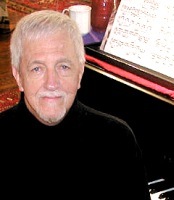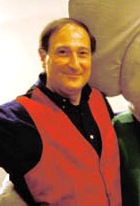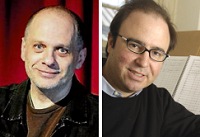The Manhattan edition of the Sequenza21/Lost Dog Ensemble concert–as seen in the New York Times–is happening tonight at 8 pm at the Good Shepherd Church, 152 West 66tth Street (between Broadway and Amsterdam). Admission is free, as in you don’t have to pay to get in. This is your last chance to see a Sequenza21 concert until we save up enough money to have another one so don’t miss it.
Our friends at Other Minds in San Francisco invented the New Music Séance in 2005, and after two sold-out editions, they’re back with a third. The event will feature three concerts of hypnotic, spiritual and rarely-heard musical gems spanning the past 100 years, offered in the intimate candlelit surroundings of Bernard Maybeck’s 1895 Arts and Crafts-style Swedenborgian Church in San Francisco. Performers Sarah Cahill (piano) (you go girl) , Kate Stenberg (violin), and Eva-Maria Zimmermann (piano) will channel new music’s progenitors alongside composers of today, in works for solo piano and violin piano duet.
The marathon features three distinct concerts tomorrow, December 6, 2008: Concert I, “Birds in Warped Time” at 1pm; Concert II, “Deep River Dreams” at 4pm; and Concert III, “Ruth Crawford and Her Milieu” at 8pm. The final concert will be preceded by a special discussion of Ruth Crawford by Professor Judith Tick of Northeastern University, Crawford’s biographer. All events take place at Swedenborgian Church, 2107 Lyon Street, San Francisco. Tickets are on a sliding scale (individual concerts / 3-concert series): SEER ($25 / $65), MEDIUM ($40 / $110), PSYCHIC ($60 / $170). (Forget it, Jake. It’s Chinatown.) Complimentary refreshments are provided for all ticket-holders, and series tickets at the PSYCHIC level include 6pm buffet dinner with the artists. The first two editions of the New Music Séance were sold out, and seating is limited to 100 persons per show, so early ticket purchase is recommended. Tickets are on sale now, at www.BrownPaperTickets.com or by calling (800) 838-3006. For information, visit otherminds.org or call (415) 934-8134.
And Lower East Side Performing Arts, Inc. will present Zendora Dance Company and the music of the lovely and gifted Elodie Lauten in a special Holiday Benefit on Tuesday, December 9 – 7:30 PM at Lafayette Bar & Grill, 54 Franklin Street (between Broadway and Lafayette) in Manhattan.
The program will be a special avant-premiere with improvisations from the Zendora Dance Company based on the second act of The Two-Cents Opera, Elodie Lauten’s semi-autobiographical fantasy about writing an opera where real, surreal and supernatural co-exist. Hmmm…. looks like a pattern developing here. Suggested donation for this benefit event is $10. For reservations or more information, please call 212-388-0202 or visit http://www.geocities.com/lesperformingarts for program information.
 My concert on the Interpretations Series on November 20th will mark the third time that I have presented my compositions on this prestigious series. These concerts have featured my works for flute and piano, vocal pieces for Thomas Buckner and the Yamaha Disklavier™ and keyboard works that combine the unique features of the Yamaha Disklavier™ as a concert piano and as a controller keyboard.
My concert on the Interpretations Series on November 20th will mark the third time that I have presented my compositions on this prestigious series. These concerts have featured my works for flute and piano, vocal pieces for Thomas Buckner and the Yamaha Disklavier™ and keyboard works that combine the unique features of the Yamaha Disklavier™ as a concert piano and as a controller keyboard. Thirteen Ways of Looking at a Black Bela
Thirteen Ways of Looking at a Black Bela Unlike the album driven days of yore, today it’s all about the mix. From purchasing single tracks digitally at online stores such as Itunes and Amazon to the internet radio sensation Pandora, which tailors ‘stations’ to a listener’s preferences, music is presented as eminently accessible; instant gratification, inevitable. While all aforementioned methods of mix are exciting in their potential for discovery, surfing the impossibly
Unlike the album driven days of yore, today it’s all about the mix. From purchasing single tracks digitally at online stores such as Itunes and Amazon to the internet radio sensation Pandora, which tailors ‘stations’ to a listener’s preferences, music is presented as eminently accessible; instant gratification, inevitable. While all aforementioned methods of mix are exciting in their potential for discovery, surfing the impossibly 

 How does it sound – a double concerto written by a musician weaned on Beethoven, salsa, Stravinsky and Bulgarian folk music? In short – like nothing else!
How does it sound – a double concerto written by a musician weaned on Beethoven, salsa, Stravinsky and Bulgarian folk music? In short – like nothing else! Big Ups to David Lang and Christopher Theofanidis who have just been appointed to the faculty of the Yale School of Music. They will teach graduate students in the school’s composition program as well as teach courses and participate in the performances of their works. Both earned masters and DMA degrees from the Yale School of Music before embarking on their illustrious careers.
Big Ups to David Lang and Christopher Theofanidis who have just been appointed to the faculty of the Yale School of Music. They will teach graduate students in the school’s composition program as well as teach courses and participate in the performances of their works. Both earned masters and DMA degrees from the Yale School of Music before embarking on their illustrious careers. Marvin Rosen has a very special program coming up this Wednesday on his always brilliant radio program.
Marvin Rosen has a very special program coming up this Wednesday on his always brilliant radio program.